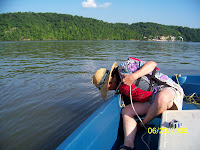
Greetings from the Lake of the Ozarks! Caroline Toole, here, working with LOWA (Lake of the Ozarks Watershed Alliance) and AmeriCorps (MO Clean Water AmeriCorps Program, hosted by MO River Communities Network (MRCN)), in service to our community!
Well, I thought things might slow down a bit once we submitted the watershed management plan (which has been approved by EPA and MO DNR), but May turned out to be full of Clean Water events and activities!
Earth Day is Every Day! May found LOWA still active with lots of school children. A return trip to Climax Springs R-IV to visit the 3rd, 4th, and 6th grades for a more focused look at water quality measurements was almost rained out but we managed to set up our equipment at the ball field and bring creek water up from the Outdoor Classroom. Rain again altered plans at Mills Elementary with the School of the Osage 2nd grade (about 150 of them!). Rather than activities at their Outdoor Classroom, we played a watershed game up under a covered walkway – at least we could stay outside, sort of! Our watershed game from Project Wet was a big hit this year with students ranging from Kindergarten to 5th grade. This activity illustrates the benefits of a riparian buffer in reducing the amount of runoff reaching a body of water. Much fun was had by all!







This AmeriCorps member also trained to be a part of the E. coli Cove Study at the Lake of the Ozarks. This season sampling will occur at three locations around the Lake. One set of coves is from about mile marker 34 at the Hurricane Deck Bridge to about the 60 mile marker, in Camden County. Another location is the set of coves in Gravois arm. And the last location is a couple of coves near Bagnell Dam that have tested high several times over the course of this 5-year study. With the help of LOWA volunteers to collect the water samples, three times as many sites have been able to be sampled in this study which is in its 4th year. Here's a picture of those pesky waterfowl.

Lakes of Missouri Volunteer Program (LMVP) is also a part of this AmeriCorps member’s monitoring activities. This program has volunteers sampling lake waters all around the lake. I monitor at mile marker 51 on the Lake of the Ozarks, and my husband helps out by piloting the boat and recording data. Coffman Marina sponsors us by letting us use their boat ramp free of charge. We only have a little 12’ putt-putt boat so we go out towards late afternoon on a weekday to avoid the larger power boats. Sampling for LMVP entails a temperature reading, a Secchi disc reading, and the collection of a water sample. At home, we then take the water sample and filter it twice each for two measurements and prepare a water sample for storage. Then all samples and filters are stored in the freezer for later pick up. For an old science type like me, this is just way too much fun!





Another May activity for LOWA was to observe and video the preparation of a pervious concrete driveway at a Green Home being built near the Lake. Pervious concrete (one type of pervious pavement) is a green construction practice that helps to reduce runoff and increase the amount of infiltration from precipitation events.


But probably the most exciting May activity has been gearing up for LOWA’s Two Dam Days Paddle Race, taking place in late September. This will actually be two races in one as well as Clean Water Festivals and the promotion of Clean Water Activities at the Lake of the Ozarks. The Two Dam Days Paddle Race will be a marathon kayak and canoe race from Truman Dam in Warsaw (near the 92 mile marker) to Bagnell Dam in Lake Ozark (near the zero mile marker!). The marathon racers will begin Saturday morning at Drake Harbor and try to make it to Captain Ron’s at the 34 mile marker by dark (7 am to 7 pm); we don’t want racers out on the Lake after dark. Then the marathoners will continue Sunday morning and race from Captain Ron’s to Iguana Sports on the Bagnell Dam Strip at the end of the lake. The marathon race should be very exciting but Saturday will also find the Just For Fun recreational race that will leave Halfway Inn at the 48 mile marker and race to Captain Ron’s, about 14 miles. Oz Cycles and Kayaks is sponsoring prizes, etc for the Just For Fun Race and various other businesses will be sponsoring the divisions and categories of the marathon portion of the Two Dam Days Paddle Race. LOWA has planned this race for late September to avoid a lot of the large power boats on the Lake during the summer and to bring in some late season activity for the Lake area businesses.

June looks to be just about as busy as May. Talk to you all next month!













